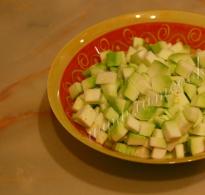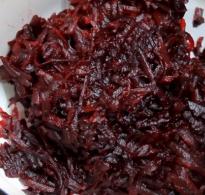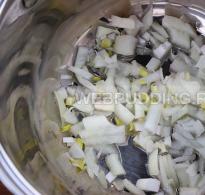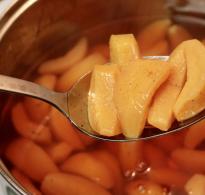Yellow is like an orange. Orange wren or blood orange
All citrus fruits are valuable source vitamin C, as well as other beneficial microelements and nutrients. Culinary use citrus fruits are very diverse: juice, zest, pulp - everything goes into use. It is obtained from the peel of the fruit aroma oil, zest and juice are seasoned with the most different dishes, and the pulp of some citrus fruits is eaten as an independent dessert.
From our encyclopedia of citrus fruits, you will learn about some representatives of this unique family. It's quite large, and over time we hope to tell you about all of them.
Bergamot or bergamot orange ( bergamot = bergamot orange) - a small sour orange, in culinary purposes For the most part, only the zest is used. Do not confuse this citrus fruit with the herb of the same name. Lime can be used as a substitute for bergamot.

Blood or pigment orange ( blood orange = pigmented orange) - these red-fleshed oranges are most popular in Europe; they are less known in other countries. They go on sale in winter and spring. You can replace blood orange with regular oranges or tangerines.

Buddha fingers or finger citron ( Buddha"shandcitron =Buddha"sfingerscitron =fingeredcitron) - Very aromatic fruit original form, resembling fingers, has practically no flesh, but consists only of peels from which candied fruits are prepared. In cooking it is often replaced with citron or lemon.

grapefruit) is a large, slightly pungent species of the citrus family. The peel is usually yellow with a green or red tint. The flesh of grapefruits can be red, pink or white(more precisely, a creamy shade). The color of the pulp does not affect the aroma and taste of grapefruit. When buying grapefruit, choose fruits that are not the largest and rather heavy for their size. Some varieties of grapefruit are seedless. The best grapefruits can be bought in winter and spring. You can replace grapefruit with ugli fruit, which is more aromatic, pomelo, which is less sour and caustic, or tangelo, a hybrid of tangerine and grapefruit.

Kaffirlime =jerukpurut =leechlime =limaupurut =magrood =makroot =makrut) - Thai chefs use this fruit to give dishes a special and strong flavor. Kafir lime contains very little juice, so for the most part only its zest is used. Replace with citron, lime or kaffir lime leaves (1 tablespoon kaffir lime zest is equivalent to 6 kaffir lime leaves). Used in Thai, Indonesian and Cambodian cuisine.
musky lime
Calamansi or musk lime ( kalamansi = kalamansi lime = calamansi = calamansi lime = musk lime = musklime) - Very sour citrus, the shape resembles a small round lime, and the taste is something between lemon and tangerine. Very popular in the Philippines. Replaced with calamondin, lemon or tangerine.

keylime =Floridakeylime =Mexicanlime) - much smaller in size and much more sour in taste than the regular Persian lime. Juicy fruit with many seeds. Many chefs even prefer bottled Mexican lime juice. fresh juice Persian limes for cooking. An adequate replacement is lime.

kumquat) - resemble oranges the size of grape berries. Unlike most citrus fruits, kumquats are eaten whole, including the skin. The taste is a little sour, but very aromatic. Originally from China, where they are considered a symbol of good luck and prosperity. Replaced with limequats, calamondins and Seville oranges (for making marmalade).

Lemon is a very sour citrus fruit that is rarely eaten on its own, but its juice, zest and peel are very widely used. On average, you can squeeze 2-3 tablespoons of juice from one lemon. There are many varieties of lemon: Eureka, which is most often found on sale, the Lisbon lemon ( Lisbon lemon), which is smaller in size than the Eureka and smoother, Meyer lemon ( Meyer lemon), which is becoming increasingly popular for its more good taste. What to replace: in pies - with grapefruit, in soups and marinades - with lemongrass, otherwise - with lime or citron, if only peel and zest are required.

These tart green fruits are similar to lemons, but they are more sour and have a distinct, unique flavor. The many varieties of limes include the Persian lime ( Persian lime) and Mexican lime ( Mexican lime). When purchasing limes, choose dark green, small specimens that are heavy in weight for their size. 1 lime yields approximately 2 tablespoons of juice. You can replace it with lemon (but then you should use more lemon juice or zest, because lemon is less sour than lime) or calamansi.

limequat) - a hybrid of lime and kumquat. It is similar in shape and size to a kumquat, but with green or yellow-green skin. Has a strong lime aroma. Depending on culinary purposes, limequat can be replaced with kumquat or lime.

mandarin orange) - has a very pleasant aroma, but their biggest advantage is that they are very easy to clean. The variety of varieties includes tangerine ( tangerine), juicy honey tangerine ( honey tangerine = Murcott), satsuma ( satsuma orange), sweet and tiny clementines ( clementine orange), tangerines with orange flavor ( temple orange). Replaced by: oranges.

Meyer lemon) - tastes more pleasant than ordinary lemon, therefore it is highly valued by gourmet chefs. Can be quite difficult to find in stores. You can replace it with plain lemon.
Citrus is a genus of evergreen trees and shrubs of the Rutaceae family. The list of citrus fruits is quite long. They are used not only in cooking, but also in perfumery. Not everyone knows about their rich diversity: many have not even heard of the bizarre names of some citrus fruits. What they have in common is their benefits and pleasant, fresh smells.
All citrus fruits have a rich composition with many useful substances
Benefits of citrus fruits
Representatives of the Rutov family can easily replenish the menu healthy eating and make the taste of many dishes brighter.
Different types of citrus fruits have beneficial properties, thanks to the composition. They contain:
- organic acids;
- vitamins (C, B, E, PP, B2, A);
- essential oils;
- mineral salts;
- calcium, copper, phosphorus and iron.
Brief characteristics of all species of the genus
Despite many similarities, the varieties of citrus fruits also have differences, and each of them is used for its own purpose. To use them to provide positive impact on the body, it is enough to determine which types of citrus fruits will be more beneficial for a person at the moment.
Agli, or uglifruit
Combines the properties of tangerine, orange and grapefruit. Its name comes from the English word “ugly” (“ugly”). The fruit looks unappetizing: it has a yellow-green wrinkled peel. But inside, agli, like many citrus fruits, is sweet. The taste has hints of light grapefruit bitterness. There are no seeds in the pulp. The ripe uglifruit fruit, 10–15 cm in diameter, is usually quite heavy for its size. Citrus is popular in Western European countries.
Remember: if, after pressing on the charcoal fruit peel, deep depressions form on it, it has begun to deteriorate.
Orange
It belongs to hybrids and was obtained as a result of natural crossing of pomelo and tangerine. The fruit was first discovered in China. Orange is one of the sweetest citrus fruits. In addition to its juiciness, it has the ability to have a beneficial restorative effect on the body, elevate mood and improve the functioning of the gastrointestinal tract. There are about 100 varieties of oranges in the world.
Lemon
The most prominent representative of the Rutov family. It is the result of crossing lime and citron. There is a version that lemon is a descendant of orange and lime. This citrus is native to South Asia. The acidity of lemon species depends on the conditions in which they grow. The advantages of this fruit are:
- the presence of a large amount of vitamin C;
- the ability to enhance the taste of dishes;
- rendering beneficial influence on the liver, stomach and intestines.

Lemons are the most popular citrus fruit in the world.
Mandarin
The symbol of the New Year, familiar to everyone since childhood, is divided into many varieties: the color of some can be pale yellow, while others can be bright orange.
Mandarin participated in the “birth” of many hybrids. These include natsumikan, tangelo and calamondin.
The fruit can increase the overall tone of the body. For many gardeners, the fact that tangerine trees are more frost-resistant than others is important. citrus plants, but along with all the advantages, there is also one disadvantage: its excessive consumption can cause allergies.
Blood orange, or "wren"
The result of mutation of the common orange into natural conditions. It is popularly called “bloody” because of its rich red flesh. There are also specimens with light red flesh. The fruits of this plant have bright taste, have no seeds, easy to clean. Blood orange is an ingredient in various gourmet dishes and is included in many diets. The “wren” was first found in Sicily.
A genus of evergreen plants. It was obtained by crossing citron and bitter orange. The tree is distinguished by a lush crown and the presence of leathery oblong-ovate leaves. Bergamot has low taste qualities: the fruits of the plant are sour and bitter. But it, like all types of citrus fruits, has exquisite aroma Therefore, the fruit is widely used in perfumery. Bergamot was brought from southeast Asia.

Bergamot is similar to lime, but has a specific smell
Gayanima
The fruit is a hybrid of citron and lemon. The tree is hardy and does not require careful maintenance, and its branches are covered with long thorns (2–4 cm). The leaves are large and shiny. The Gayanima fruit has a smooth lemon-yellow skin. The pulp of the fruit is different pleasant smell, but very sour in taste, so it is often used for marinades. Inside the fruit there are a large number of small seeds. Gayanima grows only in India.
Grapefruit
It is a descendant of orange and pomelo. The name of this citrus fruit was made up of two English words"grape" (grapes) and "fruit". This is explained by the fact that citrus fruits are often collected in clusters similar to grapes. A ripe grapefruit weighs 300–500 g.
Not everyone likes a fruit that has a bitter taste, but real gourmets often prefer this type of tart citrus fruit. Fruit grains can be either yellow or red. The richness of the color of the pulp indicates the ripeness of the grapefruit. This fruit was first discovered in Barbados and then in Jamaica.
The smallest representative of the Rutov family. The tree is also small in size - 1.5 m in height. The fruit is oval with rounded edges. Its peel is thick, but chews easily and has a sweet taste. Kumquat is used in fresh, and may also be part of various sauces. Its homeland is southeast Asia.

Kumquat can be eaten with the peel
Pomelo
Refers to citrus fruits. The fruit comes from China. Compared to other representatives of this group, he is very large. The maximum weight of a pomelo is 10 kg, but on the shelves of Russian supermarkets you can mainly find specimens weighing no more than 1.5 kg. The pulp is light yellow has sweet taste. The zest of pomelo is yellow and green.
Lime
The green “brother” of lemon. Its main purpose is to add piquancy to the taste of desserts and cocktails. Small round fruits are superior in quality to large ones. Lyme was first noticed on the island of Malacca. The leaves of this plant are prized in cooking for their aroma. Like all citrus fruits, lime is rich in various vitamins.
Pomeranian
A bitter variety of orange. Hybrid of tangerine and pomelo. Citrus is not consumed fresh; it is used in cooking to make jams and marmalade. Pomeranian is grown as an ornamental plant. Its fruits exude pleasant smell; They are round in appearance with a wrinkled skin of yellow-orange color with spots of light red color. Orange essential oils are often used in medicine, perfumery and cosmetology. Citrus is native to Asia.
Yemeni Citron (Estrog)
A special sweet variety of citron, characterized by a very thick peel. There is little pulp in it. Its peculiarity is the absence of a characteristic that unites all other citrus fruits - a pronounced pleasant aroma.

Agli looks like Sweetie
Karna
It is a hybrid of lemon and orange. The fruit has an unpleasant sour and at the same time bitter taste. There is practically no smell. Citrus pulp is used to make marmalade and candied fruits. Karna is used in medicine as a cure for many diseases. internal organs. This fruit is grown in India and China.
A complete list of citrus fruit species contains many varieties native to Japan.
Dekopon
According to some experts, it is a hybrid of two types of tangerines. The fruit is larger than a regular tangerine and has an elongated tip. The pulp is juicy and sweet. A striking advantage of dekopon is the absence of seeds. The peel of the fruit is orange, thick and lumpy. Citrus is low-calorie.
Yekan
It arose as a result of crossing a tangerine and a pomelo. By size, weight and color of the fruit this type The citrus fruit is reminiscent of grapefruit, but there is a significant difference: the pulp of yekan has a more pleasant taste.
This variety includes both tangerines and oranges. These are very sweet tasting seedless fruits. They are added to various desserts and consumed fresh. Mikan is often preserved and juiced.

Mikan - Japanese tangerines
Kikudaidai
Appeared as a result of crossing orange and grapefruit. Kikudadai is a type of inedible citrus fruit: its fruits have a bitter-sour taste, so the beautiful plant usually serves only a decorative function.
Natsudaidai
A natural hybrid of pomelo and orange. The peel is dense, yellow in color. Natsudaidai has a sour taste, but is consumed fresh. A distinctive feature of this fruit is its high content folic acid.
Mandarin, kumquat, what next? In this article we will talk about the most famous varieties of citrus fruits that are sold with us, how they differ from each other and what beneficial properties they have. By the way, citrus fruits have been crossed with each other many times over the past 200 years, and among their many species it is already difficult to say “where is the beginning and the end.” Interesting fact : In Costa Rica, citrus fruits are excellently used by capuchin monkeys as a balm against insect bites and as an antifungal agent.
. One of the most sour citrus varieties. The fruit is usually small in size, round, slightly elongated, bright yellow in color (often confused with lime, which is green in color). The juice is most often extracted from the pulp, which has a sour taste, but is extremely beneficial for health and is used as medicine in many cultures. The zest is often grated and used in various medicines. There are several subspecies of lemon, the main difference between them is taste (lemons are more sour and less sour).
Another favorite type of citrus fruit. Orange is a round fruit of bright orange (rarely reddish) color, slightly larger than a lemon. Orange is one of the most commonly consumed citrus fruits in the world, along with lemon, lime and grapefruit. Oranges can be eaten on their own or added to variety of dishes and drinks. Oranges are an excellent way to cleanse the body and remove toxins and other harmful substances from it. Oranges also have an extremely beneficial effect on human blood, making it less viscous. Orange also has several subspecies, the most famous of which is "blood orange" those. orange with reddish pulp. It tastes sweeter than a regular orange, but otherwise is not much different from its brother.
Grapefruit. Grapefruit is much larger than lemon and orange and has a slightly bitter taste. The peel of this type of citrus fruit is usually pale yellow with a reddish or green tint, the pulp is red, white or pink color, depending on the variety, but the color of the pulp is just a “decoration”; it does not affect the taste of the grapefruit. Grapefruit – excellent remedy In order to “throw off” everything unnecessary, including kilograms and toxins, the main thing is not to abuse it. It is not recommended to eat more than one grapefruit per day.
Mandarin. Everyone's favorite New Year's citrus. Mandarin looks like an orange, only a little smaller and its shape is more “flattened”, and the taste is sweeter. This variety of citrus fruit has a very pleasant aroma, but its biggest advantage is that it is very easy to clean. Mandarin and tangerine juice- an excellent remedy for ARVI and Influenza. The variety includes mandarin, juicy honey mandarin, satsuma, sweet and tiny clementines, and orange-scented mandarins.
Lime. This variety of citrus fruit is often confused with lemon, but their tastes vary greatly. Green lime fruits do resemble lemons in shape, but have a more pungent, sour taste and a special unique aroma. Lime, like lemon, is rarely eaten raw; most often, juice is made from lime, which is then used to dress salads or added to drinks, alcoholic and non-alcoholic. Few people know about this, but Lime is extremely good for your teeth! A variety of lime varieties include Mexican lime, kaffir lime (used in Thai cuisine, as a seasoning), musky lime and some other varieties.
Pomelo. Pomelo is a type of citrus fruit, very similar to grapefruit, both in appearance and in taste (slightly sweeter than grapefruit). This citrus has a very thick skin, so you will have to work hard to peel it. Pomelo is an excellent source of energy for the whole day, a pomelo eaten in the morning will more than replace the most hearty breakfast and will help you stay in good shape until the evening. Also, this citrus, along with tangerines, perfectly helps to recover from various colds and strengthen the immune system.
Kumquat. The kumquat can be described as an orange the size of a grape. Unlike most citrus fruits, kumquats are eaten whole, including the skin. The taste is a little sour, but very aromatic. In China, this variety of citrus fruit is considered a symbol of good luck and prosperity.
Buddha's fingers. The last type of citrus is Buddha's Fingers or finger citron - a very aromatic fruit with an original shape that resembles fingers. This citron has practically no flesh, but consists only of skin. Most often it is used to make candied fruit or marmalade, and is also used as a seasoning in some cuisines around the world.
These are, perhaps, the main types of citrus fruits that can be found on sale. There are many more varieties, but all of them are either subspecies of those already listed above (for example, bergamot, aka bergamot orange), or their hybrids. Among the common hybrids, for example, tangelo– a hybrid between a tangerine and any other citrus fruit, or uglifruit- a hybrid of tangerine and grapefruit. A mineola, which is often brought into stores, is a variety of tangelo.
They all differ from each other in appearance and in their taste, but the “set” of beneficial properties of all citrus fruits is approximately the same. All varieties of citrus fruits are a valuable source of vitamin C, as well as other beneficial trace elements and nutrients. In cooking, citrus fruits are used in their entirety, from juice, pulp to zest and peel.
From fruit peel aromatic oil is obtained, a variety of dishes are seasoned with the zest and juice, and the pulp of some citrus fruits is eaten as an independent dessert. When choosing this or that citrus, you should focus, first of all, on how you will use it (how independent dish or as a seasoning), since the taste of some varieties of citrus fruits may not be very pleasant. However, there is a simple rule: if citrus cannot be eaten, then you can squeeze juice out of it, which will be almost healthier than the fruit itself. Bon appetit!
Svetlana Shakhova
What are the most famous citrus fruits? Most Europeans' list is limited to orange, tangerine, lemon and grapefruit. However, in total there are more than 60 species. Most of them appeared through crossing different varieties and hybridization. However, not all of them are eaten. Some, such as bergamot, are used as a flavoring. But still, many citrus fruits can enrich the usual diet and bring benefits.
Orange
Despite the fact that today the orange is one of the most common citrus fruits, it originally did not exist in nature. It is believed that 2500 BC. e. it was obtained by crossing a mandarin and a pomelo in China. From here, already in the 15th century, the first orange trees were brought to Europe, and it even became fashionable to grow them in special greenhouses. They quickly took root on the southern coast of Spain, France, and later in the USA.
Oranges are those citrus fruits that doctors recommend eating daily. They have a general strengthening effect on the body, improve mood and help normalize digestion. A glass of orange juice with breakfast will give you strength for the whole day and improve your appetite. In addition, it is recommended for diabetes, fever (as a source of fluid) and vitamin deficiency.
In addition to the classic ones, blood oranges, or oranges, are also common in Europe. They are distinguished from ordinary ones by their bright red flesh and sweeter taste. Otherwise, they are similar to traditional ones and may well replace them. In total, there are more than 30 varieties of oranges that differ from each other appearance and taste.
Lemon
The main competitor of orange in popularity among Europeans can be safely called lemon. He is even more often remembered when asked to name citrus fruits. But lemon is also not found in the wild. However, it is not known exactly when it was cultivated. Southeast Asia is considered the birthplace of lemon. Most likely, the first hybrids appeared in India and from there were brought to Europe back in the 12th century.

Lemons, despite their high acid content, are recommended to normalize digestion in cases of high acidity. Regular use eating them will strengthen the immune system due to great content vitamin C. Thanks to its taste properties Lemons are often used in cooking. It is used to prepare lemonade, which is popular all over the world. Also pieces of fresh fruit are added to strong tea. He is known throughout the world as "Russian".
Mandarin
Originally from southern China, these very common citrus fruits only arrived in Europe towards the end of the 19th century. But thanks to the fact that they were easy to peel (hence their name) and had a sweetish pulp, tangerines quickly gained popularity. As a result, there were different varieties- from pale yellow to bright orange. And based on them, many hybrids have been created: tangerine and orange - natsumikan, tangerine and grapefruit - tangelo, tangerine and kumquat - calamondin, as well as some others.

Perhaps the main useful property of all tangerines and hybrids based on them is that they help restore strength in a protracted winter period. They will help cope with the blues and strengthen immune system. They are also recommended for consumption by heart patients, pregnant women and those suffering from chronic bronchitis. True, they should be eaten with caution, since excess fruit can cause severe allergies.
Grapefruit
This hybrid of orange and pomelo has been common in Europe for quite some time. And this despite its specific bitter taste. And the thing is that daily use grapefruit promotes weight loss even while maintaining your usual diet. Based on it, a special diet has been developed, where it is proposed to complete each meal with half of this fruit.
But this is not the only benefit that grapefruit has. It, like many other citrus fruits, - a real treasure trove organic acids, vitamins (C, P, D and B1) and naringin, which is beneficial for the heart muscle. Moreover, it is believed that grapefruit juice improves mood and is an excellent antidepressant. It should be used with caution only when taking contraceptives and medications to lower blood pressure, as well as for people with ulcers, allergies and when increased acidity stomach.

Pomelo
For most, the named 4 types are all citrus fruits. What other fruits are included in this category? First of all, it’s worth mentioning the pomelo. After all, this is one of the few wild citruses cultivated by humans. Also based on it, many hybrids have been created (for example, orange and grapefruit). It differs from its counterparts in its rougher skin, impressive size and fibrous pulp. However, it is much sweeter than the same oranges and lemons.
In China, the pomelo is considered a symbol of prosperity and is often given as a gift on major holidays. And this is no coincidence. It normalizes metabolism, helping to cleanse the body and reduce weight. It is also suitable as a preventative for hypertension, heart disease and cancer. Just like other citrus fruits, the names of which have already been mentioned here, it is not recommended if you are prone to allergic reactions.
For many centuries and even millennia, citrus fruits have been juicy and tasty. Fruits have always been considered the most healthy products for humans, as they contain all the most important nutrients necessary for its normal existence. Fresh fruit They do not require a long digestive process for absorption, so they can be consumed little by little at any age, unless there is an individual intolerance or allergy. Currently grown in the world huge amount citrus fruits, the fruits of which are not only edible, but also very healthy and aromatic. Further in the article “ Citrus fruit: list of names and photos” you can familiarize yourself with the most famous of them.
One of the most useful for humans
Lemon is an evergreen tree with a spreading or pyramidal crown. Has aromatic, leathery leaves that contain essential oil and fall once every three years. The flowers are pink or cream in color and have a delicate scent. Can be grown as an indoor crop. As a rule, the lemon tree blooms in the spring, and the juicy, light yellow fruits with lumpy skin ripen only in the fall. But this depends on the variety and place of growth. Lemons are very beneficial for humans. They contain the following substances:
If you eat one small lemon a day, you can gradually reduce high blood pressure, reduce blood viscosity, improve vascular elasticity. But use these valuable fruits Not everyone can. Lemons sharply increase the acidity of gastric juice, and people with diseases of the gastrointestinal tract should eat them with great caution and only after consulting their doctor on this issue. Like all citrus fruits, they can cause an allergic reaction, especially in children.
Lemon fruits are used in cooking, the alcoholic beverage industry, and perfumery. In Russia, there has long been a tradition of drinking tea with lemon. Lemonade is often prepared from these fruits - very popular natural drink, which has a refreshing effect. The recipe for its preparation is extremely simple: fresh lemon juice Grind thoroughly with sugar and dilute with water. The amount of ingredients can be taken according to personal preferences.
This plant has been known to people since ancient times. It has been established that oranges were successfully grown in China 2.5 thousand years BC. Currently considered the most widespread crop of all citrus fruits. It grows in the tropics and subtropics, and in countries with unsuitable climates it is grown in greenhouses. The lifespan of individual trees can reach up to 150 years. Taste qualities better large fruits with a thin crust.
Oranges contain a whole complex of vitamins and a large number of biologically active substances. Orange juice has long been considered an antiscorbutic remedy. It is useful to eat oranges to prevent a number of diseases of such important organs as the liver and heart. The high content of vitamin C helps the body fight against colds. Noted positive influence systematic consumption of these fruits on the condition of blood vessels. Pectins contained in oranges improve intestinal motility and reduce putrefactive processes. Fresh Orange juice considered one of the best and healthy drinks. Orange slices They are actively used in cooking, and all kinds of infusions, liqueurs, and jams are made from the zest. Orange oil is also produced from it. Fruits should be consumed with caution due to the possibility allergic reaction and exacerbation of gastrointestinal diseases.
This evergreen tree can grow up to 5 m in height, and the fruit harvest reaches up to seven thousand pieces. They usually ripen in November or December, depending on the variety. Tangerines are easy to clean, the peel is easily separated from the pulp. The fruits are very aromatic, usually sweeter than an orange.
The peel of a tangerine contains no less useful substances than the fruit. Therefore, delicious and delicious food is prepared from it. healthy jam, infusions, added to compotes, teas.
Due to the large amount of sugar contained in the tangerine fruit, it should not be eaten by people suffering from pancreatic diseases, including diabetes mellitus. Those who have inflammatory processes in their veins should completely abstain from their use. gastrointestinal tract, gastritis, liver diseases. Children who have an individual intolerance to these fruits or allergies should not eat tangerines.
The largest of the citrus fruits
Pomelo is a huge evergreen tree that can reach a height of 15 m. Pale green, yellow or orange fruits They have a fairly thick skin. Sometimes they are found with a mass of 10 kg. The fruits are sour, with a bitter aftertaste. In China, pomelo was known even before our era. In the 14th century it was first brought to Europe by sailors. IN Southeast Asia, and also in China is considered a symbol of prosperity. It is used during religious celebrations as offerings to spirits.
This fruit is very useful because high content vitamin A, the presence of a lipolytic enzyme that promotes faster breakdown of fats and absorption of proteins. It contains useful substances such as potassium, calcium, iron, and fiber. Limonoids, present in all citrus fruits and pomelo in particular, inhibit the growth of breast cancer cells.
Pomelo is usually eaten raw or made into pie fillings. fruit salads, added to seasoning for meat and fish dishes.
The fruit was first obtained in 1931 in Florida. The Mineola fruit is large in size, flattened in shape, and has a thin red-orange rind. The fruit pulp has 10 - 12 lobules, it sweet and sour taste, with a pleasant aroma and a small number of seeds. Contains a lot of folic acid, 100 g, depending on ripeness and growing conditions, can be up to 80% daily norm for a person. Therefore, it is very important for pregnant women to use it, but only after consulting with their doctor. Improves the elasticity of blood vessels. The fruits are most often consumed fresh or made into fresh or canned juices. The zest is used in cooking.
Conclusion
Citrus fruits are loved not only by children, but also by many adults. Their tasty pulp- a real storehouse of vitamins and nutrients. However, their bitter seeds also contain a lot of magnesium, potassium and calcium, and the peel contains beneficial essential .Citrus fruits, list of names, photos detailed description will provide an opportunity to become more fully acquainted with their beneficial properties. Selection of species and different varieties These fruits are very diverse. If you want to try new, previously unknown fruits, you should not buy them at large quantities, first you need to find out the body’s reaction - whether allergic symptoms will appear or you simply won’t like the taste.






